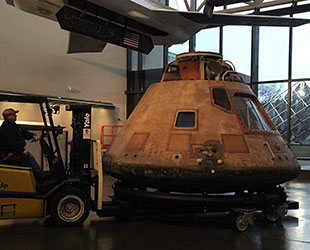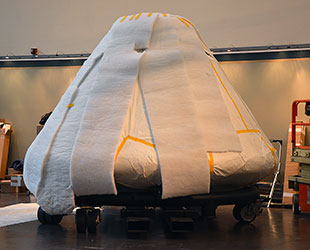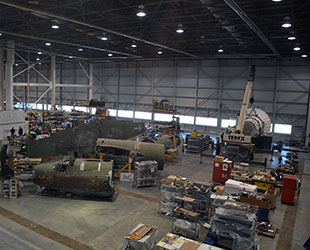Dec. 19, 2016 – Drivers in the Washington, D.C.-area may soon catch sight of one of the United States' most historic spacecraft and not even know it.
The Smithsonian's National Air and Space Museum is now organizing to move Columbia, NASA's Apollo 11 command module that flew Neil Armstrong, Buzz Aldrin and Michael Collins on the first moon landing mission, to the museum's restoration facility at the Steven F. Udvar-Hazy Center in northern Virginia. There, the space capsule will undergo a six-month conservation to be ready for its next exhibition.
In preparation for the upcoming move — Columbia's first departure from the Air and Space Museum in 40 years — conservators have wrapped the iconic spacecraft in layers of protective padding and plastic. As such, when the truck carrying it does hit the road, only the shape of the capsule may hint at its identity.
"They'll think it is big Hershey's Kiss," joked Allan Needell, Columbia's curator at the National Air and Space Museum, in an interview with collectSPACE.

Columbia, the Apollo 11 command module, is moved into a closed gallery so it can be prepared for its departure. (Smithsonian) |
From July 1976 until August 2015, the command module was prominently displayed as part of the museum's central Milestones of Flight Hall. It was then moved the short way into the Space Race Hall, where a team of specialists used state-of-the-art technology to scan Columbia's interior and exterior to create a high-resolution, digital 3D model.
Now, with its delivery to the Mary Baker Engen Restoration Hangar at the Udvar-Hazy Center, conservators will have the chance to thoroughly document its condition and arrest some of its ongoing degradation as a result of Columbia's splashdown from the moon almost half a century ago.
"There are some indications there is still some salt water contamination, which is continuing to have some effect, so that can be ameliorated," described Needell. "Some of the exterior heat shield is continuing to scrape off, so that can be stabilized."
Most of the conservation work though, will be focused on research.

Columbia, the Apollo 11 command module, is seen being wrapped for its move to the Steven F. Udvar-Hazy Center. (collectSPACE) |
"The conservation is mostly documentation," said Needell. "Some research as to the [spacecraft's] original materials, paints and coatings."
The effort is to ensure that Columbia is ready to go back on permanent display at the Air and Space Museum as a centerpiece of its new Apollo-focused gallery, "Destination Moon," slated to open sometime around 2020. The gallery, which is replacing the original second floor gallery, "Apollo to the Moon," will also feature Neil Armstrong's Apollo 11 spacesuit, which is also now undergoing a conservation at the Udvar-Hazy.
"The design [of 'Destination Moon'] is coming along quite well," said Needell. "I'm really, really happy with how that is all coming together."
In the interim, after its conservation is complete, Columbia may travel some more. The Smithsonian confirmed reports that it is planning to tour with the spacecraft to mark the 50th anniversary of the Apollo 11 lunar landing in 2019.

View looking into the Mary Baker Engen Restoration Hangar at the Steven F. Udvar-Hazy Center in Chantilly, Virginia. (collectSPACE) |
"We are trying to organize a tour. The number of stops and venues is still to be determined," said Needell. "A formal announcement will come next year."
As for the schedule of Columbia's pending transport to the Udvar-Hazy, the Smithsonian does not publicize the exact dates when it moves artifacts. So, "soon" is the best that can be said.
"We'll announce when it is there, but the move itself will be done privately so as to not draw a lot of attention," Needell said.
The Mary Baker Engen Restoration Hangar at the Udvar-Hazy features large overhead viewing windows from which the public can see inside, so Columbia will remain visible as it being conserved.
